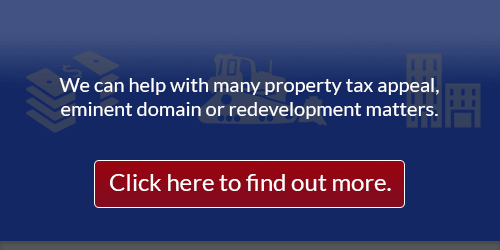Tax Court Reduces Multi-Year Tax Assessments for NJ Shopping Center
On September 13, 2021, New Jersey Tax Court rendered a fifty-four (54) page opinion in Green Eagle Property Resources, LP v. Mansfield Township (hereafter “Green Eagle”) that reduced the 2014, 2015, 2016, 2017, and 2018, multi-year tax assessments for a community shopping center located at 1885 State Route 57, Mansfield Township, Warren County, New Jersey. The unpublished opinion, written by the Honorable Joshua D. Novin, J.T.C., provides valuable guidance regarding the sufficiency of evidence required to (1) overcome the presumption of correctness that attaches to local tax assessments, and (2) demonstrate, by a fair preponderance of the evidence, that the local property tax assessment was erroneous.
In Green Eagle, the subject property was improved with a one-story community shopping center commonly known as Mansfield Commons. The shopping center is divided into two separate buildings: The first building, located along the western boundary of the property, is a one-story Walmart comprising approximately 123,519 square feet (“Building One”), the second building comprises approximately 145,627 square feet and includes three large retail stores, an 88,830 square foot Kohl’s department store, a 21,674 square foot Marshalls department store, and a 15,000 square foot Party City store (“Building Two”). Building Two also includes eleven smaller “in-line” retail stores ranging in size from 1,200 to 4,000 square feet. Adjacent to Building Two, on the property’s eastern boundary, is an Arby’s fast-food restaurant, comprising approximately 2,900 square feet. The Arby’s restaurant is included in Building Two’s total square footage. In sum, the subject property contains a total of 272,046 square feet of leasable area, inclusive of the Arby’s restaurant. The property owner timely filed complaints challenging the subject property’s 2014, 2015, 2016, 2017, and 2018 tax year assessments. The Tax Court tried the matters to conclusion over several days and heard testimony from one of the property owner’s principals and two New Jersey certified general real estate appraisers. Each appraiser prepared an appraisal report and expressed opinions of the subject property’s true value as of the October 1, 2013, October 1, 2014, October 1, 2015, October 1, 2016, and October 1, 2017 valuation dates.
As an initial matter, the Court concluded that the property owner produced cogent evidence sufficient to overcome the presumption of validity that attached to the initial assessments. Specifically, the opinions of the property owner’s expert, if accepted as true, raised debatable questions as to the validity of the subject property’s tax assessments.
While making the preliminary finding that the property owner had submitted sufficient evidence to overcome the presumption of validity, the burden of proof remained on the property owner to demonstrate that the assessment was incorrect. The Court then proceeded to address the substantive valuation issues. The property owner’s expert relied primarily on the income approach. He also applied a “hybrid” approach which he conceded was less reliable as an indicator of value. His “hybrid” approach valued the Walmart portion of the property under the cost approach and the remainder of the property under the income approach. Mansfield’s expert also relied upon a “hybrid” approach, valuing the Walmart portion of the property by the cost approach and the remainder by the income approach. The Court ultimately rejected the experts’ “hybrid” approaches, finding that they contained too many challenges in arriving at a value for the subject property, particularly in attempting to value the land. Thus, the Court applied the “income capitalization approach” to value the entire property.
The “income capitalization approach” consists of methods, techniques, and mathematical procedures that an appraiser uses to analyze a property’s capacity to generate benefits (i.e., usually the monetary benefits of income and reversion) and convert these benefits into an indication of present value.” The Appraisal of Real Estate, 439 (14th ed. 2013). Central to the approach is a determination of the “market rent” or “fair rental value.”
Applying the “income-capitalization approach” to value the subject property’s market rent, the Court gave significant weight to the property owner’s expert testimony regarding comparable properties and rental values. The Court concluded that the true value of the subject property was $32,100,000, as of the October 1, 2013, October 1, 2014, October 1, 2015, October 1, 2016, and October 1, 2017 valuation dates. Thus, the Court corrected the local property assessment by applying the new true value to the guidance contained in N.J.S.A. 54:51A-6(a), commonly referred to as Chapter 123. The following table demonstrates the Court’s judgment for each tax year in question:
| Tax Year | New Assessment |
| 2014 | $32,100,000 |
| 2015 | $30,883,400 |
| 2016 | $30,389,100 |
| 2017 | $30,218,900 |
| 2018 | $29,731,000 |
Judge Novins’s comprehensive decision in Green Eagle demonstrates that property tax appeals can be complicated, and each case presents its own intricacies. The complexity of a case is only compounded when the application seeks to challenge multiple tax assessments for a large property that contains a wide range of retail sales establishments. From initial intake to final resolution, an experienced tax appeal attorney can help you navigate through the specifics of each individual case. If you have a question concerning your property tax assessment, contact McKirdy, Riskin, Olson & DellaPelle, P.C. to speak with an experienced attorney. To view the full Green Eagle decision, click here.







